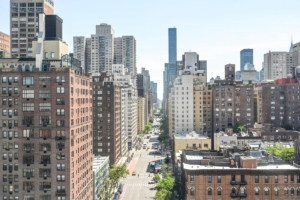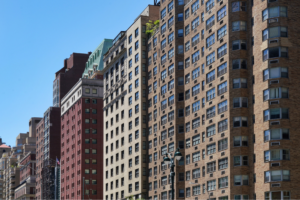Price growth in Manhattan’s sales market plateaued at the end of the year as competition tempered across the borough, according to the Q4 2016 StreetEasy® Market Reports[i]. Upper Manhattan – comprised of Harlem, Inwood, Washington Heights, Hamilton Heights and Manhattanville – continued to be an outlier in the borough, still experiencing relatively strong price growth.
From StreetEasy economist Krishna Rao:
“Manhattan’s housing market over the past few years has been at the mercy of climbing luxury prices. Now, stagnating price growth is spreading from the top end of the market to the middle, while demand for lower-priced homes increases. The end of 2016 foreshadowed what we expect to see in 2017 – increased competition in relatively affordable areas like Upper Manhattan, and even more price cuts in the luxury sector as Manhattan’s market finds equilibrium.”
Brooklyn’s sales market also had little annual growth in Q4, dragged down by price declines and price cuts in North Brooklyn, which is comprised of Williamsburg and Greenpoint.
“Brooklyn is synonymous with what’s considered cool in New York City real estate, but that cool-factor could be reaching a peak,” Rao said. “Price growth is slowing, with prices even falling in North Brooklyn last quarter. This could be due to L train fears, or simply buyer fatigue in the face of Williamsburg’s luxury prices.”
See below for more highlights from the Q4 2016 StreetEasy Market Reports.
Competition Cools in Manhattan…
- In Manhattan, the median resale price grew 0.7 percent year-over-year in the fourth quarter to $983,205, the slowest annual quarterly growth since Q4 2010[ii].
- Almost 40 percent of all Manhattan sales listings had a price cut in the fourth quarter and Manhattan sellers received a median of 97.4 percent of their asking price, compared to almost 100 percent last year.
- Manhattan pending sales, or homes that went into contract fell 3.7 percent year-over-year and homes spent 64 days on market, an increase of 10 days since last year.
…With the Exception of Upper Manhattan
- The Upper Manhattan submarket continued to have the strongest price growth in the borough, where the median resale price increased 8.8 percent to $658,332.
- Upper Manhttan also had the smallest share of inventory with a price cut (26.7 percent), and a sale-to-list price ratio of 100 percent, meaning sellers typically received their full asking price.
- By contrast, resale prices in both the Upper East Side and Downtown submarkets decreased in the fourth quarter, falling 2.1 percent and 0.3 percent year-over-year, respectively.
- Homes in the Upper East Side submarket also had the most price cuts, exceeding the borough median by 3.5 percent.
[tableau server=”public.tableau.com” workbook=”Q42016CompetitiveMetricsComparison” view=”Dashboard2″ tabs=”no” toolbar=”no” revert=”” refresh=”yes” linktarget=”” width=”600px” height=”670px”][/tableau]
Brooklyn’s Price Growth Weighed Down by North Brooklyn
- In Brooklyn, the median resale price increased 3.8 percent year-over-year in the fourth quarter to $560,493.
- North Brooklyn was the only submarket in the borough where resale prices fell, decreasing 2.9 percent since last year.
- North Brooklyn also had the largest share of inventory with a price cut (41.1 percent). Homes in the submarket spent a median of 83 days on market, which was longer than any other submarket in the borough, and an increase of 31 days compared to this time last year.
- Median resale price in the Northwest Brooklyn submarket, consisting of neighborhoods such as Dumbo and Gowanus, increased the most of all Brooklyn submarkets, rising 7.8 percent year-over-year to $869,153.
[tableau server=”public.tableau.com” workbook=”priceIndices” view=”StreetEasyPriceIndex” tabs=”no” toolbar=”no” revert=”” refresh=”yes” linktarget=”” width=”600px” height=”820px”][/tableau]
Manhattan Rental Market Overview
- Manhattan’s rental market closely mirrored the sales market, with median monthly rent increasing just 1.2 percent year-over-year to $3,216, according to the StreetEasy Rent Indices[iii].
- Median rent in the Upper Manhattan submarket increased the most, with rents rising 6.2 percent year-over-year to $2,436.
- The Upper East Side submarket was the only submarket where rents decreased compared to last year, falling 0.3 percent year-over-year to $2,681.
Brooklyn Rental Market Overview
- Median monthly rent in Brooklyn decreased 0.2 percent year-over-year to $2,819.
- Northwest Brooklyn and North Brooklyn median rent decreased 0.2 percent and 4.6 percent, respectively.
- South Brooklyn median rent increased the most year-over-year, up 5.5 percent.
[tableau server=”public.tableau.com” workbook=”2016Q4MarketOverview” view=”Dashboard2″ tabs=”no” toolbar=”no” revert=”” refresh=”yes” linktarget=”” width=”600px” height=”870px”][/tableau]
[i] The StreetEasy Market Reports are a monthly overview of the Manhattan and Brooklyn sales and rental markets. Every three months, a quarterly analysis is published. The report data is aggregated from public recorded sales and listings data from real estate brokerages that provide comprehensive coverage of Manhattan and Brooklyn, with most metrics dating back to 1995 in Manhattan and 2005 in Brooklyn. The reports are compiled by the StreetEasy Research team. For more information, visit http://streeteasy.com/blog/market-reports/. StreetEasy tracks data for all five boroughs within New York City, but currently only produces reports for Manhattan and Brooklyn.
[ii] Median resale price is measured by the StreetEasy Price Indices. Also referred to as the StreetEasy Manhattan Price Index (MPI) and StreetEasy Brooklyn Price Index (BPI), the metrics are monthly indices that track changes in resale prices of condo, co-op, and townhouse units. Each index uses a repeat-sales method of comparing the sales prices of the same properties since January 1995 in Manhattan and January 2005 in Brooklyn. Given this methodology, each index accurately captures the change in home prices by controlling for the varying composition of homes sold in a given month. Data on sales of homes is sourced from the New York City Department of Finance. Full methodology here: http://streeteasy.com/blog/methodology-streeteasy-price-indices/
[iii] Similar to the StreetEasy Price Indices, median rents are measured by the StreetEasy Rent Indices. By including only valid and verified listings from StreetEasy and employing a repeat rentals approach, the indices emphasize the changes in rent on individual properties and not between different sets of properties. Full methodology here: http://streeteasy.com/blog/methodology-streeteasy-rent-indices/









